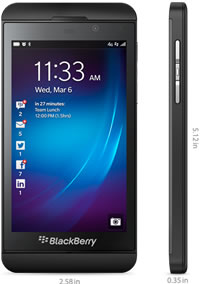Difference between Asus PadFone Infinity and Blackberry Z10
Key Difference: The Asus Padfone Infinity smartphone is a slick 5-inch full HD 1920x1080, Super IPS+ with Capacitive Multi touch panel and provides approximately 441 ppi density. The device is a bar phone, with curved corners giving it a similar look to the ‘iPhone’ and ‘HTC One’. The Asus Padfone Infinity Dock is basically the 10-inch tablet shell that allows users to dock their phone into the tablet by sliding it into a slick slot on the back. The Blackberry Z10 is the latest smartphone that has been released in January 2013 by Research in Motion. The Z10 is a bar phone that is available with a 4.2 inch capacitive touch screen that has approximately 355 ppi pixel density, providing a clear and sharp display. If supports a 1.5 GHz Dual-core Krait, 2GB RAM with 16 GB internal storage capacity and expandable capacity up to 64 GB.
 Asus has announced its latest phone and tablet in the Padfone series, knighted the Asus Padfone Infinity. The original Asus Padfone did not reach the Western Shores but the company states that the Padfone Infinity is set for world-wide launch in the second quarter of 2013. Similar to the original Padfone, the Padfone Infinity is available just as smartphone or along with a tablet dock that allows seamless transition between phone and tablet needs. The Padfone Infinity is a pretty intriguing concept that allows the phone to dock on the tablet, which powers the tablet and transfers all the data on the tablet for use. However, without the phone the tablet is just a shell without any ‘brain’ of its own. The phone/tablet is set to provide serious competition to rivals Sony Xperia Z Tab, iPad 4 and Samsung Galaxy Tab. Let’s cover its features separately.
Asus has announced its latest phone and tablet in the Padfone series, knighted the Asus Padfone Infinity. The original Asus Padfone did not reach the Western Shores but the company states that the Padfone Infinity is set for world-wide launch in the second quarter of 2013. Similar to the original Padfone, the Padfone Infinity is available just as smartphone or along with a tablet dock that allows seamless transition between phone and tablet needs. The Padfone Infinity is a pretty intriguing concept that allows the phone to dock on the tablet, which powers the tablet and transfers all the data on the tablet for use. However, without the phone the tablet is just a shell without any ‘brain’ of its own. The phone/tablet is set to provide serious competition to rivals Sony Xperia Z Tab, iPad 4 and Samsung Galaxy Tab. Let’s cover its features separately.
The Asus Padfone Infinity smartphone is a slick 5-inch full HD 1920x1080, Super IPS+ with Capacitive Multi touch panel and provides approximately 441 ppi density, making the screen visibly sharp, crisp and clear. The device is a bar phone, with curved corners giving it a similar look to the ‘iPhone’ and ‘HTC One’. The phone has a sleek metallic chassis, with a silver brushed look on the back. The phone is powered by the latest 1.7GHz quad-core Krait Qualcomm Snapdragon 600, providing fast responsiveness from the device. It offers the latest Android v4.2 Jelly Bean. The phone has a 2GB RAM and is available with 32/64 GB of internal storage capacity. The phone houses a 13MP primary camera and a 2MP secondary camera, with HD recording capability. The massive battery power allows the phone to provide up to 19 hours of 3G talk time. The company also introduced a bunch of new features such as Asus Echo, SuperNote, ASUS Story, Instant Dictionary and two years’ free Cloud Storage with 50GB ASUS WebStorage. The Asus Echo is the newest personal assistant, similar to Siri that allows the user to activate a number of features (search contacts, make calls, pick up incoming calls, activate the camera shutter for self-portraits, set alarms, change settings, etc) on the phone using voice commands. The new SuperNote supports real-time handwriting to text conversion and is sensitive enough to accurately translate from handwriting to text. Asus Story allows users to create albums and story lines, while Instant Dictionary allows users to translate words, phrases and sentences in emails, web pages or apps.
The Asus Padfone Infinity Dock is basically the tablet shell that allows users to dock their phone into the tablet by sliding it into a slick slot on the back. The slot comes with rubber gromits that ensures that the phone locks into place and does not slide out and fall. When the phone is docked on the tablet, the tablet and the phone synchronize automatically and the apps that were on the screen of the phone automatically re-sizes itself and pops up on the tablet screen. The tablet sports a 10.1 Full HD 1920x1080, Super IPS+ with Capacitive Multi touch panel, similar to the phone, providing a clear and detailed picture on the tablet. The screen on both, the phone and the tablet, have a Corning Gorilla Glass covering. The tablet does not have a processor or anything such hardware on it. It does offer a few advantages to the phone. The tablet houses a 1MP front camera for video calls. The tablet is also capable to output 1080 Full HD video via Micro-USB compatible MyDP interface. The device also has a dialer and is able to accept and make phone calls and send text messages. The phone and the tablet have speakers have the ASUS Audio Wizard audio enhancement providing rich audio experience. The battery as a massive 5000 mAh Li-Polymer, that enhances the battery power of the phone allowing up to 40 hours of 3G talk time. The tablet also has the power to charge the phone three times with a full battery. The tablet starts charging the battery of the phone, when the phone is docked into the tablet.
The high-end phone/tablet hybrid comes with a high-end price of EUR 999 and should be around US$ 1300 when it finally reaches the States. The main purpose of such a hybrid is so that people can use one data plan and it eliminates the need for manually synchronizing the tablet to phone and vice-versa. The phone has also been criticized for the lack of the keyboard, which was one of the features available in the original Padfone. Will the phone be a massive success or failure will be seen when the phone finally becomes available world-wide.
 The Blackberry Z10 is the latest smartphone that has been released in January 2013 by Research in Motion. The phone is powered by the company’s BB10 and is believed to be the company’s latest attempts to capture the smartphone market. The Z10 is a bar phone that is available with a 4.2 inch capacitive touch screen that has approximately 355 ppi pixel density, providing a clear and sharp display. The phone is also light in weight and perfect for one-hand operation. If supports a 1.5 GHz Dual-core Krait, 2GB RAM with 16 GB internal storage capacity and expandable capacity up to 64 GB. The Z10 has an 8MP auto-focus camera along with 2MP front-facing camera for video conferencing. The camera offers a new Time Shift mode that allows users to pinpoint and adjust individual elements of a picture.
The Blackberry Z10 is the latest smartphone that has been released in January 2013 by Research in Motion. The phone is powered by the company’s BB10 and is believed to be the company’s latest attempts to capture the smartphone market. The Z10 is a bar phone that is available with a 4.2 inch capacitive touch screen that has approximately 355 ppi pixel density, providing a clear and sharp display. The phone is also light in weight and perfect for one-hand operation. If supports a 1.5 GHz Dual-core Krait, 2GB RAM with 16 GB internal storage capacity and expandable capacity up to 64 GB. The Z10 has an 8MP auto-focus camera along with 2MP front-facing camera for video conferencing. The camera offers a new Time Shift mode that allows users to pinpoint and adjust individual elements of a picture.
The users can interact with the OS using gestures such as swipe, tap, pinch, and reverse pinch. The phone comes with a few new features such as Hub, Balance, Story Maker and Remember. The Hub is a screen that is available by swiping left after the first menu page and task switcher and it is creates a single point where the user can check all updates from SMS, e-mail to facebook notifications. It also offers the users to post messages, update twitter, facebook and any other services. BlackBerry Balance is a feature that allows people to separate their work life from their personal life. It allows easy access to creating two separate profiles, where work related and personal related profiles can be kept separate and maintained. Story Maker is an app that allows users to create a story by selecting photos and an audio clip to go along with it. The app will automatically create a video and will also include effects. The new keyboard on the Z10 has an adaptive feature that learns as the user types words and also suggests future words that can be used making typing e-mails and messages easier. Many reviews do state that one of the downfalls of the phone is the camera as well as lack of apps. The camera is not as sharp as it could be and the phone does not offer many apps in the BlackBerry World store.
The information for the detailed table about the two phones has been taken from the Asus website, Blackberry website and GSMArena.com.
|
|
Asus Padfone Infinity |
BlackBerry Z10 |
|
Launch Date |
Expected Release Q2/2013 |
January 2013 |
|
Company |
Asus |
Research In Motion |
|
Size |
Phone:143.5 x 72.8 x 8.9 mm Pad: 264.6 x 181.6 x 10.6 mm |
130 x 65.6 x 9 mm |
|
Display |
Phone: 5-inches, Full HD 1920x1080, Super IPS+ with Capacitive Multi touch panel Pad: 10.1-inches, Full HD 1920x1080, Super IPS+ with Capacitive Multi touch panel |
4.2 inches capacitive touchscreen |
|
Screen |
Phone: 1080 x 1920 pixels (~441 ppi pixel density) Pad: 1920x1080 pixels (~441 ppi pixel density) |
768 x 1280 pixels (~355 ppi pixel density), 16 million colors |
|
Protection |
Corning Gorilla Glass on both the phone and the pad. |
Password protection, screen lock, and sleep mode, BlackBerry® Balance™ offering dedicated profiles to keep work and personal data separate and secure. |
|
Weight |
Phone: 141 grams Pad: 530 grams |
137.5 g (4.83 oz) |
|
2G Network |
GSM 850 / 900 / 1800 / 1900 |
GSM 850 / 900 / 1800 / 1900 - all versions |
|
3G Network |
HSDPA 900 / 2100 |
HSDPA 850 / 900 / 1900 / 2100 - STL100-1 HSDPA 850 / 900 / 2100 - STL100-2 |
|
4G Network |
LTE 800 / 1800 / 2600 / 2100 |
LTE 800 / 900 / 1800 / 2600 - STL100-2 |
|
GUI |
Asus' UI |
Blackberry UI |
|
CPU speed |
1.7GHz quad-core Krait Qualcomm Snapdragon 600 |
1.5 GHz Dual-core Krait |
|
GPU |
Adreno 320 |
Adreno 225 |
|
OS |
Android v4.2 (Jelly Bean) |
BlackBerry 10 OS |
|
Chipset |
Qualcomm APQ8064T Snapdragon 600 |
Qualcomm MSM8960 Snapdragon |
|
RAM |
2 GB |
2 GB RAM |
|
SIM Size |
nanoSIM |
microSIM |
|
Internal Memory |
32/64 GB |
16 GB |
|
Expandable Memory |
N/A |
Up to 64 GB |
|
Sensors |
G-Sensor, E-compass, Gyroscope, Proximity, Light Sensor |
Accelerometer, magnetometer, proximity sensor, gyroscope, ambient light sensor |
|
Connectivity |
GPRS Class 10, EDGE Class 10, LTE, Bluetooth, Wi-Fi, USB, Wi-Fi hotspot. |
Wi-Fi, 2G, 3G, 4G, NFC, Bluetooth 4.0 and microUSB 2.0. |
|
Data |
GPRS, EDGE, WLAN, Bluetooth, NFC, USB, USB Host. |
GPRS, EDGE, WLAN, Bluetooth, NFC and USB |
|
Speed |
DC-HSPA+, 42 Mbps; HSDPA, 21 Mbps; HSUPA, 5.76 Mbps; LTE, Cat3, 50 Mbps UL, 100 Mbps DL |
HSDPA 21 Mbps, HSUPA 5.76 Mbps; LTE, EV-DO Rev. A, up to 3.1 Mbps |
|
WLAN |
Wi-Fi 802.11 a/ac/b/g/n, Wi-Fi Direct, dual-band, Wi-Fi hotspot |
Wi-Fi 802.11 a/b/g/n, dual band |
|
Bluetooth |
Bluetooth v4.0 with A2DP |
Bluetooth v4.0 with A2DP, LE |
|
USB |
microUSB v2.0 (MHL), USB Host |
microUSB v2.0. |
|
Primary Camera |
13 MP, 4128 x 3096 pixels, autofocus camera |
8 megapixel auto-focus camera |
|
Secondary Camera |
Phone: 2 MP 1080p@30fps camera Pad: 1MP front camera |
2 megapixel fixed-focus camera with image and video stabilization, 3x digital zoom and 720p HD video recording |
|
Video |
1080p@30fps |
1080p HD video recording with 4 DOF (Degrees of freedom) video stabilization |
|
Camera Features |
|
|
|
Sound Enhancement |
ASUS Audio Wizard ASUS Sonicmaster |
No |
|
Audio supported formats |
MP3/3GP/AAC/AAC+ |
3GP, 3GP2, WMA, MP3, MKA, AAC, AMR, F4V, WAV, MP2PS, MP2TS, AWB, OGG, FLAC |
|
Video supported formats |
MP4/H.264/H.263 player |
M4A, M4V, MOV, MP4, MKV, MPEG-4, AVI, ASF, WMV, |
|
Battery Capacity |
Phone: 2400 mAh Li-Polymer Pad: 5000 mAh Li-Polymer |
Li-Ion 1800 mAh battery |
|
Talktime |
Phone: 3G: 19 hours Pad: 3G: 40 hours |
3G: Up to 10 hours |
|
Standby Time |
Phone: 3G: 410 hours Pad: 3G: 920 hours |
3G: Up to 13 days (312 hours) |
|
Available Colors |
Titanium Gray, Champagne Gold, Hot Pink |
Black, white |
|
Messaging |
SMS(threaded view), MMS, Email, Push Email, IM |
SMS, MMS, Email, Push Email, IM, BBM 6 |
|
Browser |
HTML5 |
HTML5 |
|
Radio |
FM radio |
No |
|
GPS |
A-GPS & GLONASS |
Yes, with A-GPS support |
|
Java |
Yes, via Java MIDP emulator |
MIDP 2.1 |
|
Additional Features |
|
|
Image Courtesy: asus.com, us.blackberry.com









Add new comment